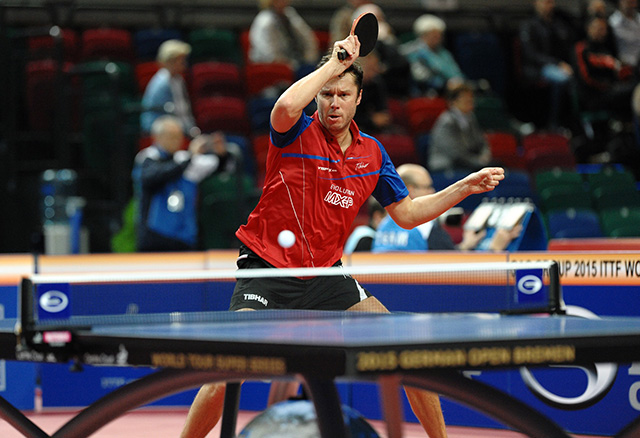It may surprise many people to hear that table tennis can be a very physically demanding sport. Being fit for table tennis is more important at the higher levels of competition. At all levels, skill and tactics are very important, while at the advanced playing level, being physically fit can give you an edge over your opponent.
 table tennis serve
table tennis serveIn our discussion of the fitness components of table tennis, the was clear that the most important attributes of a good table tennis player is speed and agility. Flexibility and aerobic fitness should also not be avoided
Why Fitness Training
Fitness training should be conducted by advanced table tennis players to supplement the skill, technique and tactical training done at the table.
Fitness training should be done in all areas, focusing on those more relevant for the sport of table tennis, and based on any strengths or weaknesses of the individual identified through fitness testing.
Warm-Up
At the start of each training session or before any games, a good warm-up should be performed. The warm-up should start at a low intensity, with a gradual progression in intensity.
Flexibility
It is important to maintain flexibility, and stretches should be performed before all training sessions as part of the warm-up, and afterwards when fully warmed up if extra stretching is required.
Dynamic stretches are best to maintain optimal range of motion in joints and muscles. Incorporate yoga or Pilates sessions to improve flexibility, balance, and body awareness.
Endurance
Incorporate aerobic exercises such as running, cycling, or swimming to improve overall cardiovascular fitness. Aim for at least 30 minutes of moderate-intensity cardio activity most days of the week.
Speed and Agility
Speed and agility are crucial in table tennis as they enable players to quickly reach the ball and make rapid changes in direction. Here are some example agility drills for table tennis players:
- Lateral Shuffle: Set up two markers (cones or lines) about 5-10 feet apart. Shuffle quickly laterally between the markers, maintaining a low stance and quick footwork. Focus on keeping your feet light and staying balanced throughout the movement.
- Multi-Directional Cone Drills: Arrange several cones in a random pattern on the floor. Practice moving around the cones in various directions, including forward, backward, sideways, and diagonally. Use quick, precise steps to navigate the course while keeping your eyes up and scanning for the next cone.
- Agility Ladder Drills: Utilize an agility ladder or create a makeshift ladder with tape on the floor. Perform ladder drills such as the two-feet-in, two-feet-out, lateral shuffles, and crossover steps. These drills improve foot speed, coordination, and agility.
Strength and Power Training
Strength training plays a vital role in enhancing the performance of table tennis players by improving stability and power. Focus on developing strength in the lower body, core, and upper body to enhance power and stability during gameplay. Incorporate exercises like squats, lunges, planks, push-ups, and rows using resistance bands or free weights. For explosive power training, integrate plyometric drills such as jump squats, box jumps, and lateral hops.
Here are some example strength exercises for table tennis players:
- Squats: Strengthen the lower body, particularly the quadriceps, hamstrings, and glutes, which are essential for explosive movements and stability during gameplay. Perform bodyweight squats or progress to weighted squats using a barbell or dumbbells.
- Lunges: Target the lower body muscles while also improving balance and coordination. Forward lunges, reverse lunges, and lateral lunges help strengthen the quadriceps, hamstrings, and glutes, mimicking the lunging movements often used in table tennis footwork.
- Bent-Over Rows: Strengthen the upper back, shoulders, and arms, which are crucial for maintaining posture and generating power during table tennis strokes. Perform bent-over rows using a barbell, dumbbells, or resistance bands to improve upper body strength and stability.
- Push-Ups: Build upper body strength, particularly in the chest, shoulders, and triceps, essential for executing powerful shots and maintaining stability during gameplay. Variations such as wide-grip, narrow-grip, and decline push-ups provide progressive resistance and target different muscle groups.
- Core Exercises: Strengthen the core muscles, including the abdominals, obliques, and lower back, to improve stability, balance, and rotational power during table tennis strokes. Incorporate exercises such as planks, Russian twists, and bicycle crunches to enhance core strength and endurance.
- Medicine Ball Throws: Develop explosive power and coordination by performing medicine ball throws, including overhead throws, chest passes, and rotational throws. These exercises simulate the dynamic movements and quick changes in direction required in table tennis gameplay.
As with all fitness training, you should remember the principle of progressive overload. Start easy and progressively increase the intensity over time, gradually forcing the body to adapt and improve. Overall it is important to listen to your body, stay hydrated, and adjust your training intensity based on your individual needs and goals.
Related Pages
- Anthropometry for Table Tennis
- Warm-Up for Table Tennis
- Fitness Components for Table Tennis
- List of Table Tennis Polls
- Fitness for Sports
- Stretching for Sports


 Current Events
Current Events